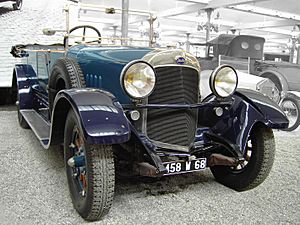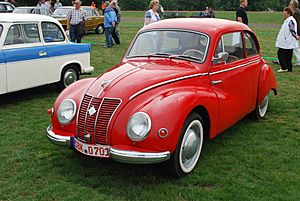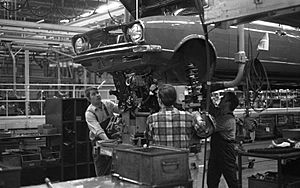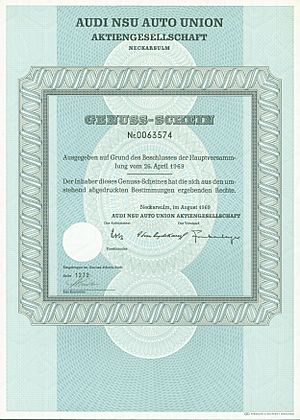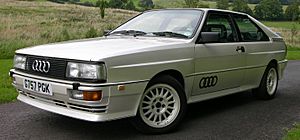Audi facts for kids
 |
|
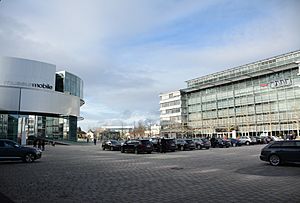
Audi Forum (Ingolstadt, Germany): Museum and headquarters of the carmaker.
|
|
| Subsidiary (AG) | |
| Industry | Automotive |
| Predecessors |
|
| Founded |
|
| Founder | August Horch |
| Headquarters | , |
|
Number of locations
|
13 production facilities in 10 countries |
|
Area served
|
Worldwide |
|
Key people
|
Markus Duesmann (Chairman of the Board of Management & Board of Management Member for Technical Development and Product Lines) |
| Products | Luxury vehicles |
|
Production output
|
|
| Revenue | |
|
Operating income
|
|
| Total assets | |
| Total equity | |
|
Number of employees
|
90,783 (12/2019) |
| Parent | Volkswagen Group |
| Divisions |
|
| Subsidiaries |
|
| Footnotes / references Audi History: Chronicle, 2011 Annual Financial Report |
|
Audi AG is a famous German company that makes luxury vehicles. Its main office is in Ingolstadt, Bavaria, Germany. Audi is part of the Volkswagen Group and builds cars in nine factories around the world.
The company's story began in the early 1900s. It started with companies like Horch and Audiwerke, founded by engineer August Horch. Later, two other car makers, DKW and Wanderer, joined them to create Auto Union in 1932. The Audi we know today really began in the 1960s. That's when Volkswagen bought Auto Union from Daimler-Benz. Volkswagen brought back the Audi brand in 1965 with the Audi F103 series. Then, in 1969, Auto Union merged with NSU Motorenwerke, forming the company as it is now.
The name "Audi" comes from the Latin translation of the founder's last name, Horch. In German, "Horch" means "listen." In Latin, "listen" is "audi." The four rings in the Audi logo stand for the four car companies that came together to form Auto Union, which was Audi's earlier company. Audi's slogan is Vorsprung durch Technik, which means "Progress through Technology." Audi, along with other German brands like BMW and Mercedes-Benz, is one of the top-selling luxury car brands globally.
History of Audi
How Audi Started and Got its Name
The car company Wanderer began in 1885 and later became part of Audi AG. Another company, NSU, also joined Audi later. NSU even provided the frame for Gottlieb Daimler's first four-wheeled vehicle.
On November 14, 1899, August Horch started his first company, A. Horch & Cie. in Cologne, Germany. He later moved his company to Reichenbach im Vogtland in 1902. On May 10, 1904, he founded a new company called August Horch & Cie. Motorwagenwerke AG in Zwickau.
After some disagreements with his partners, August Horch left his first company. On July 16, 1909, he started his second company, the August Horch Automobilwerke GmbH, also in Zwickau. However, his old partners sued him because he was still using the "Horch" name. A German court decided that the "Horch" brand belonged to his first company.
Since August Horch couldn't use his own name for his new car business, he met with friends to think of a new name. During this meeting, Franz Fikentscher's son was studying Latin. He suggested using "audi" instead of "horch." "Horch" means "listen" in German, and "audi" means "listen" in Latin! Everyone loved the idea. On April 25, 1910, the company was officially named Audi Automobilwerke GmbH Zwickau.
The first Audi car, the Audi Type A, was made in the same year. Audi started with cars that had four-cylinder engines. These cars were even successful in racing events. In 1924, Audi introduced its first six-cylinder car, the Type M.
August Horch left Audiwerke in 1920 to work for the ministry of transport, but he stayed involved with Audi as a board member. In September 1921, Audi was the first German car maker to offer a car, the Audi Type K, with the steering wheel on the left side. This design became popular because it gave drivers a better view of oncoming traffic, making it safer to pass other cars.
Four Companies Become One: The Four Rings Logo
In August 1928, Jørgen Rasmussen, who owned DKW (Dampf-Kraft-Wagen), bought most of the shares in Audiwerke AG. That same year, Rasmussen also bought parts of an American car company called Rickenbacker. He used their equipment to make 8-cylinder engines for Audi cars.
In 1932, Audi joined with Horch, DKW, and Wanderer to create a new company called Auto Union AG. This is when the four linked rings, which are Audi's logo today, first appeared. These rings stood for the four companies that came together. Auto Union also made the Audi Front, which was the first European car to have a six-cylinder engine and front-wheel drive.
Before World War II, the four rings were mainly used on Auto Union racing cars. Each member company still used its own name and logo on its regular cars. As time went on, the companies shared more technology. Some Audi models even used engines made by Horch or Wanderer.
Because of tough economic times, Auto Union started focusing more on smaller cars in the 1930s. By 1938, DKW cars made up a big part of the German car market, but Audi cars were only a tiny part. After 1939, the "Audi" name disappeared from new cars for over 20 years.
After World War II
During World War II, Auto Union factories were used to make military equipment. They were damaged by bombings during the war.
In 1945, the Soviet Army took over the factories. The Soviet Union ordered the factories to be taken apart as part of war payments. All of the company's property was taken without payment. On August 17, 1948, Auto Union AG was removed from the business register. The Audi factory in Zwickau became a "People Owned Enterprise" (VEB) called Automobilwerk Zwickau.
Since there was no way to continue making cars in East Germany, Auto Union leaders decided to move what was left of the company to West Germany. They chose a location in Ingolstadt, Bavaria, in late 1945. This new location started as a place to make spare parts and later became the main office for the new Auto Union in 1949.
The old Audi factory in Zwickau started making cars again in 1949. These were DKW models, renamed to IFA F8 and IFA F9. Both East and West German models used the well-known DKW two-stroke engines. The Zwickau plant later made the famous Trabant car until 1991, when Volkswagen took control of it.
The New Auto Union and Volkswagen
A new Auto Union company was started in Ingolstadt, West Germany, in 1949. It received loans from the Bavarian government and help from the Marshall Plan. The company continued to make front-wheel drive vehicles with two-stroke engines, like a small motorcycle and a DKW delivery van. The Ingolstadt site had many old military buildings, which were good for offices and storing cars. However, it didn't have a factory for making many cars. So, for their first mass-market car, they rented a factory in Düsseldorf. Ten years later, with new investors, they built a large car factory at the Ingolstadt headquarters.
In 1958, Daimler-Benz (the company that makes Mercedes-Benz) bought a large part of Auto Union. By 1959, they owned the whole company. However, Daimler-Benz wasn't very interested in small two-stroke cars. Even though they invested in new Mercedes models and a modern factory for Auto Union, Auto Union's older car models didn't do as well as competitors like Volkswagen. Daimler-Benz decided to sell Auto Union because it wasn't making enough money.
In 1964, Volkswagen bought 50% of Auto Union, including the new factory in Ingolstadt and the DKW and Audi brands. Volkswagen also got the rights to a new engine design that Daimler-Benz had paid for. Volkswagen then bought full control of the Ingolstadt factory by 1966. They even used the factory to build an extra 60,000 Volkswagen Beetles each year.
Two-stroke engines became less popular in the 1960s. In September 1965, the DKW F102 was updated with a four-stroke engine and a new look. Volkswagen stopped using the DKW brand because it was linked to two-stroke engines. They called the new car the "Audi" (internally, it was the F103). This was the first time the Audi name was used again after 25 years! Later versions were named after their horsepower, like the Audi 60, 75, 80, and Super 90.
At first, Volkswagen didn't want Auto Union to make its own cars. Volkswagen's boss, Heinz Nordhoff, even ordered that the Auto Union name and flags be removed from the factory. He told Auto Union engineers not to develop any new products. But the engineers, led by Ludwig Kraus, secretly developed the first Audi 100. When Nordhoff saw the finished car, he was so impressed that he approved it for production. The Audi 100 was a huge success when it launched in 1968. This brought the Audi brand back to life. After this, the first Audi 80 came out in 1972. This car helped create the design for Volkswagen's new front-wheel-drive cars.
In 1969, Auto Union merged with NSU, a company based in Neckarsulm. In the 1950s, NSU was the world's biggest motorcycle maker. They later started making small cars and then focused on new rotary engines. The new NSU Ro 80 car in 1967 was very advanced. However, problems with its rotary engines led to NSU losing its independence. Today, the Neckarsulm factory makes larger Audi models like the A6 and A8. This factory is also home to Audi Sport GmbH, which develops and produces high-performance Audi cars like the R8 and the RS models.
Modern Audi
The new company, Audi NSU Auto Union AG, officially started on January 1, 1969. Its main office was at NSU's Neckarsulm factory. This was the first time Audi became a separate brand since before the war. Volkswagen introduced the Audi brand to the United States in 1970.
After the successful Audi 100 in 1968, the Audi 80 (which became the basis for the 1973 Volkswagen Passat) followed in 1972. Then came the Audi 50 in 1974, which was later renamed the Volkswagen Polo. The Audi 50 was a very important design because it was the first version of the Golf/Polo idea, which led to a hugely successful car around the world. The Audi 80 and 100 (which later became the A4 and A6) became Audi's best-selling cars. Little money was invested in the older NSU cars. The Prinz models were stopped in 1973, and the Ro80 stopped production in 1977, ending the NSU brand.
In the 1980s, Audi's image was seen as a bit old-fashioned. An engineer named Jörg Bensinger suggested using the four-wheel drive technology from Volkswagen's military vehicle, the Iltis, for an Audi performance car and rally racing car. This led to the "Audi Quattro" in 1980. It was a turbocharged coupé and the first German car made in large numbers to have permanent all-wheel drive. Only a few of these cars were made, but the model was very successful in rallying. Its wins showed how good all-wheel-drive racecars could be, and the Audi name became known for new car technology.
In 1985, since the Auto Union and NSU brands were no longer used, the company's name was shortened to simply Audi AG. At the same time, the main office moved back to Ingolstadt. Two new companies, Auto Union GmbH and NSU GmbH, were created to own and manage the historical names and ideas of the original companies.
In 1986, the Audi 80 was updated with a completely new design. This new model sold very well. In 1987, Audi introduced the elegant Audi 90, which had many more standard features. In the early 1990s, sales of the Audi 80 series started to slow down.
In the early 2000s, Audi set out to break world records for top speed and endurance on a German racetrack. This was a nod to the company's racing history from the 1930s.
Through the early 1990s, Audi began to aim for a more upscale market, competing with Mercedes-Benz and BMW. This started with the Audi V8 in 1990. It was basically a new engine put into the Audi 100/200, but with different body parts, like a new grille built into the hood.
By 1991, Audi offered many different models: the four-cylinder Audi 80, the five-cylinder Audi 90 and Audi 100, the turbocharged Audi 200, and the Audi V8. There was also a coupé version of the 80/90.
The five-cylinder engine was strong and successful, but it was a bit different for the target market. With the new Audi 100 in 1992, Audi introduced a 2.8L V6 engine. This engine was also put into an updated Audi 80, giving that model a choice of four, five, or six-cylinder engines in sedan, coupé, and convertible styles.
The five-cylinder engine was soon phased out as a main choice, but a powerful turbocharged version remained. This engine was first used in the 200 quattro 20V in 1991 and was based on the engine from the Sport Quattro. It was put into the Audi Coupé, named the S2, and also into the Audi 100 body, named the S4. These two models were the start of Audi's mass-produced S series of high-performance cars.
Audi 5000 and Safety Improvements
In the United States, sales of the Audi 5000 models dropped in the 1980s. There were reports of cars suddenly speeding up on their own.
Investigations by the National Highway Traffic Safety Administration (NHTSA) looked into these reports. They found that many of these incidents were caused by drivers accidentally pressing the wrong pedal. They also found that Audi's idle-stabilizer system could sometimes cause small, unexpected accelerations. These small accelerations might have surprised drivers, leading them to press the wrong pedal.
Audi responded by making several changes to its cars. They adjusted the distance between the brake and accelerator pedals on automatic cars. Later, they added a device that required drivers to press the brake pedal before shifting out of park. These changes helped improve safety and prevent accidental acceleration. As a result of these events, many cars today have special gear stick patterns and brake interlock systems to help prevent accidental shifting.
Audi's sales in the U.S. fell significantly during this time. To help rebuild trust, Audi offered better warranty protection and changed the name of the affected models. The 5000 became the 100 and 200 in 1989. Audi's sales eventually returned to previous levels by the year 2000.
Audi Car Models
Current Car Models
Here are some of the Audi cars you can buy today:
|
|
S and RS Models
Audi also makes special high-performance versions of its cars, called S (Sport) and RS (Rennsport/racing sport) models. These cars have more powerful engines and sportier features.
|
|
Electric and Self-Driving Cars
Audi is working on new technologies for cars. They are planning to team up with a Japanese company called Sanyo to develop hybrid electric cars for the Volkswagen Group. This means future Audi cars might use Sanyo batteries and other electronic parts.
Audi has already shown off some cool electric concept cars, like the Audi A1 Sportback Concept and the fully electric Audi e-tron Concept Supercar.
In December 2018, Audi announced that it would invest a lot of money (about $15.9 billion) into electric cars and self-driving cars. This shows their commitment to making cars that can drive themselves and use electricity instead of gasoline.
Images for kids
-
The Audi R8 uses Audi Space Frame technology.
-
Walter Röhrl with his Quattro A2 during the 1984 Rally Portugal
-
Audi sponsors Bundesliga club Bayern Munich
-
Audi Centre Sydney, Zetland, New South Wales, Australia
See also
 In Spanish: Audi para niños
In Spanish: Audi para niños



